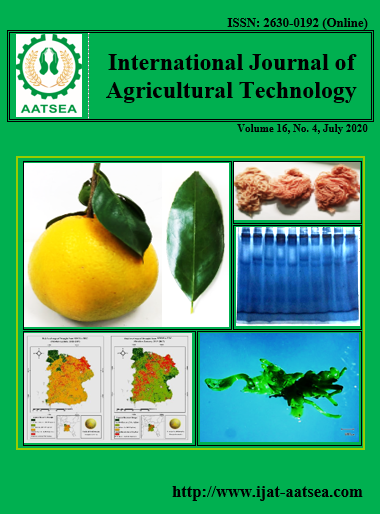Yield and growth of Pak Choi and Green Oak vegetables grown in substrate plots and hydroponic systems with different plant spacing
Main Article Content
Abstract
The yields of Pak Choi and Green Oak vegetables grown in deep flow technique hydroponic system with narrow plant spacing of 10 cm x 12 cm (HydroDFT10x12) were significantly higher than those vegetables grown in other planting systems with different plant spacings. The yield of Pak Choi grown in HydroDFT10x12 was the highest due to the highest plant density that compensated for the low fresh weight per plant, narrow canopy diameter, and low number of leaves per plant. Green Oak grown in HydroDFT10x12 had the second highest yield due to high plant density, high fresh weight per plant, highest canopy diameter, high number of leaves per plant, and tallest plant height. Yields of Green Oak grown in Sub20x25 (substrate plot with wide plant spacing of 20 cm x 25 cm) and HydroNFT20x25 (nutrient film technique hydroponic system with wide plant spacing of 20 cm x 25 cm) were lower than in other treatments caused by the lowest plant density. Pak Choi had significantly higher yield than Green Oak, as Pak Choi grown with higher plant density compensated for its lower canopy diameter, light fresh weight per plant, and lesser number of leaves per plant. Plant density was the main factor for the higher yield of Pak Choi. HydroDFT10x12 gave the significantly highest yield, which was higher than Sub20x25, Sub10x12 (substrate plot with narrow plant spacing of 10 cm x 12 cm), HydroNFT20x25, and HydroDFT20x25 (deep flow technique hydroponic system with wide plant spacing of 20 cm x 25 cm), due to the highest plant density, widest canopy diameter, tallest plant height, and high fresh weight per plant as indicated by positive values of the correlation coefficients. Therefore, the HydroDFT10x12 is the most suitable planting system for producing Pak Choi and Green Oak vegetables.
Article Details

This work is licensed under a Creative Commons Attribution-NonCommercial-NoDerivatives 4.0 International License.
References
AKA (Agricultural Knowledge Article, in Thai) (2003). Thai fruit and vegetable being both food and medicine in the lettuce episode. Faculty of Natural Resources, Prince of Songkla University, Hatyai Campus. Retrieved from http//www. natres.psu.ac.th [July 12, 2014].
BAC (Bangsai Agricultural Center, in Thai) (2014). Hydroponics and Aeroponics. Retrieved from http://www.bangsaiagro.com/samples-grown.aspx [August 31, 2014].
Decoteau, D. R. and Graham, H. A. H. (1994). Plant spatial arrangement affects growth, yield, and pod distribution of Cayenne peppers. Horticultural Science, 29:149-151.
Detpiratmongkol, S., Yoosukyingsataporn, S. and Ubolkerd, T. (2008). Effect of corm size and plant spacing on growth of Chinese water chestnut. Full paper, Proceedings of the 46th Kasetsart University Annual Conference, Kasetsart, Thailand. pp. 295-302.
Dingkuhn, M., Schnier, H. F., De Datta, S. K., Dorffling, K., Javellana, C. and Pamplona, P. (1990). Nitrogen fertilization of direct-seeded flooded vs irrigated rice: II. Interactions among canopy properties. Crop Science, 30:1284-1292.
Gardner, F. P., Pearce, R. B. and Mitchell, R. L. (1985). Physiology of crop plants. Iowa State University Press. The United States of America, p. 327.
Kathong, S. (1994). Cassava cultivation. Department of Agriculture, Bangkok, Thailand. Cassava Academic Document, pp. 71-83.
Khamwongsa, A. (2010). Ways of hydroponic vegetable production and investment for making money. Naka Intermedia Company Limited, Bangkok, Thailand.
Maneepong, S., Songkesonchat, M. and Boonsong, O. (2011). The comparison on nutrient solution for soilless vegetable culture in tropical zone. Walailak University.Center for Library Resources and Educational Media. Nakhon Si Thammarat, Thailand.
Muranyi, E. and Pepo, P. (2013). The effects of plant density and row spacing on the height of maize hybrids of different vegetation time and genotype. World Academy of Science, Engineering and Technology International Journal of Biological, Veterinary, Agricultural and Food Engineering, 7:681-684.
NRCS (Natural Resources Conservation Service) (n.d.). Lactucaserriola L. United States Department of Agriculture. Retrieved from http://en.wikipedia.org/wiki/Lettuce [28 July 2014].
Nuntagij, I. (2000). Soilless culture system. Division of Soil Science, Faculty of Agricultural Technology, King Mongkut’s Institute of Technology Ladkrabang, Thailand.
Poothong, S. (1997). Effect of shading and spacing on seed yield and quality of Capsicum frutescens cv. Tabasco. (Master Thesis). Major Field Horticulture, Department of Horticulture, Kasetsart University, Bangkok. p. 69.
Somboonya, T. (2005). The suitable nutrient solution, spacing and media on the growth of Pakchoy (Brassica chinensis L. var. chinensis) in NFT system. Special Problem, Faculty of Agricultural Technology, Valaya Alongkorn Rajabhat University, Pathum Thani Province, Thailand.
Sompituk, T. (2005). The suitable nutrient solution, spacing and media on the growth of Pakchoy (Brassica chinensis L. var. chinensis) in NFT system.Special problem, Faculty of Agricultural Technology, Valaya Alongkorn Rajabhat University, Pathum Thani Province, Thailand.
Stoffella, P. J. and Bryan, H. H. (1988). Plant population influences growth and yields of bell pepper. Journal of the American Society for Horticultural Science, 113:835-839.
Tabngoen, S., Vichukit, V., Changlek, P., Serivichayaswadi, P., Samutthong, N., Somwang, T. and Lim-aroon, S. (2004). Optimum spacing of cassava varieties: Huay Bon 60, Kasetsert 50 and Rayong 5 planted on Mab soil series. Proceedings of the 42nd Kasetsart University Annual Conference, Kasetsart, Thailand, 3-6 February 2004, pp. 318-324.
Thongket, T. (2001). Soilless lettuce culture in NFT system. Department of Horticulture, Faculty of Agriculture, Kasetsart University, Thailand.
Tongaram, D. (2004). Marketing: analysis of decision making for soilless culture. Handout for training entitled “Hydroponics: soilless culture technique” at the Thailand Institute of Scientific and Technological Research [July 21-23, 2004].
Wiangsamut, B. (2016). Manual for hydroponic culture. Department of Crop Production and Landscape Technology, Faculty of Agro-Industrial Technology, Rajamangala University of Technology Tawan-Ok Chanthaburi Campus, Chanthaburi, Thailand.
Wiangsamut, B., and Koolpluksee, M. (2016). Effect of various planting media on growth of Thao Yai Mom (Tacca leontopetaloides Ktze.). International Journal of Agricultural Technology, 12:797-809.
Wiangsamut, B., Mendoza, C. T. and Lafarge, A. T. (2006). Growth dynamics and yield of rice genotypes grown in transplanted and direct-seeded fields. Journal of Agricultural Technology, 2:299-316.


